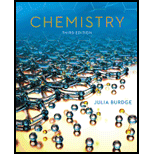
Concept explainers
Interpretation:
The molecular orbital energy level diagrams are to be drawn for
Concept introduction:
In molecular orbital theory, two or more atoms are linked together to make molecular orbitals. It predicts the arrangement of electrons in a molecule.
Molecular orbital theory consists of bonding molecular orbital and antibonding molecular orbital. Electronic structure of a molecule is described by this theory.
The respective energies of the atomic orbitals are shown by the molecular orbital energy level diagram.
Order of increasing energy of molecular orbitals is:
Each orbital can possess maximum two electrons according to Hund’s law.
Answer to Problem 70QP
Solution: The molecular orbital energy level diagram is represented below:
Explanation of Solution
Molecular orbital energy level diagram consists of bonding molecular orbital and antibonding molecular orbital. In the given information,
valence electrons,
valence electrons, and
valence electrons. Each orbital can possess maximum two electrons according to Hund’s law.
has 16 electrons
has 17 electrons and
has 18 electrons.
has configuration
has configuration
has configuration
The molecular energy level diagram is drawn for the
Want to see more full solutions like this?
Chapter 24 Solutions
Student Study Guide for Chemistry
- Write Lewis structures for NF3 and PP5. On the basis of hybrid orbitals, explain the fact that NF3, PP3, and PP5 are stable molecules, but NP5 does not exist.arrow_forwardWhat is the hybridization of iodine in IF3 and IF5?arrow_forwardThe ionization energy of O2 is smaller than the ionization energy of atomic O; the opposite is true for the ionization energies of N2 and atomic N. Explain this behavior in terms of the molecular orbital energy diagrams of O2 and N2.arrow_forward
- Platinum hexafluoride is an extremely strong oxidizing agent. It can even oxidize oxygen, its reaction with O2 giving O2+PtFt6. Sketch the molecular orbital energy level diagram for the O2+ ion. How many net and bonds does the ion have? What is the oxygen-oxygen bond order? How has the bond order changed on taking away electrons from O2 to obtain O2+? Is the O2+ ion paramagnetic?arrow_forwardGive the molecular shape around the boron atom in BCl 3 and the nitrogen atom in NCl 3 and explain why they are different.arrow_forwardBased on its molecular orbital diagram, is peroxide ion O22- paramagnetic or diamagnetic?arrow_forward
- Draw the Lewis structure of azide (N₃⁻) and then determine the hybridization of the central atom.arrow_forwardDescribe the hybridization of boron and the molecular structure about the boron in each of the following:(a) H3BPH3(b) BF4−(c) BBr3(d) B(CH3)3(e) B(OH)3arrow_forwardOxygen forms double bonds in O2, but sulfur forms single bonds in S8. Why?arrow_forward
- Iodine and oxygen form a complex series of ions, among them IO4^- and IO5^3-. Draw the Lewis structures for these ions, and specify their electron-pair geometries and the shapes of the ions. What is the hybridization of the I atom in these ions?arrow_forwardWhat is the hybridization of the central atom in the bromine pentafluoride (BrF5) molecule?arrow_forwardWrite the hybridization, shape and magnetic character of [Fe(CN)6]4-.arrow_forward
 Chemistry by OpenStax (2015-05-04)ChemistryISBN:9781938168390Author:Klaus Theopold, Richard H Langley, Paul Flowers, William R. Robinson, Mark BlaserPublisher:OpenStax
Chemistry by OpenStax (2015-05-04)ChemistryISBN:9781938168390Author:Klaus Theopold, Richard H Langley, Paul Flowers, William R. Robinson, Mark BlaserPublisher:OpenStax Chemistry: Principles and PracticeChemistryISBN:9780534420123Author:Daniel L. Reger, Scott R. Goode, David W. Ball, Edward MercerPublisher:Cengage Learning
Chemistry: Principles and PracticeChemistryISBN:9780534420123Author:Daniel L. Reger, Scott R. Goode, David W. Ball, Edward MercerPublisher:Cengage Learning Chemistry: The Molecular ScienceChemistryISBN:9781285199047Author:John W. Moore, Conrad L. StanitskiPublisher:Cengage Learning
Chemistry: The Molecular ScienceChemistryISBN:9781285199047Author:John W. Moore, Conrad L. StanitskiPublisher:Cengage Learning General Chemistry - Standalone book (MindTap Cour...ChemistryISBN:9781305580343Author:Steven D. Gammon, Ebbing, Darrell Ebbing, Steven D., Darrell; Gammon, Darrell Ebbing; Steven D. Gammon, Darrell D.; Gammon, Ebbing; Steven D. Gammon; DarrellPublisher:Cengage Learning
General Chemistry - Standalone book (MindTap Cour...ChemistryISBN:9781305580343Author:Steven D. Gammon, Ebbing, Darrell Ebbing, Steven D., Darrell; Gammon, Darrell Ebbing; Steven D. Gammon, Darrell D.; Gammon, Ebbing; Steven D. Gammon; DarrellPublisher:Cengage Learning Chemistry & Chemical ReactivityChemistryISBN:9781337399074Author:John C. Kotz, Paul M. Treichel, John Townsend, David TreichelPublisher:Cengage Learning
Chemistry & Chemical ReactivityChemistryISBN:9781337399074Author:John C. Kotz, Paul M. Treichel, John Townsend, David TreichelPublisher:Cengage Learning Chemistry & Chemical ReactivityChemistryISBN:9781133949640Author:John C. Kotz, Paul M. Treichel, John Townsend, David TreichelPublisher:Cengage Learning
Chemistry & Chemical ReactivityChemistryISBN:9781133949640Author:John C. Kotz, Paul M. Treichel, John Townsend, David TreichelPublisher:Cengage Learning





